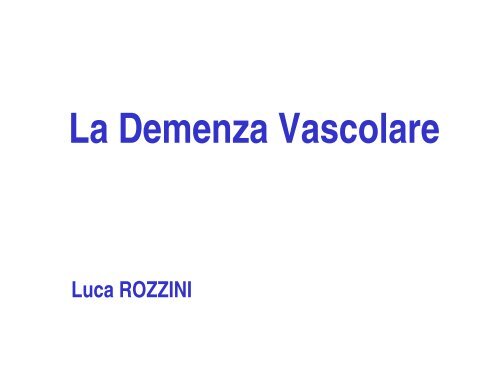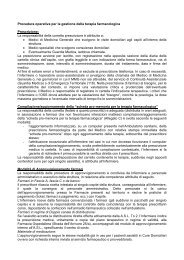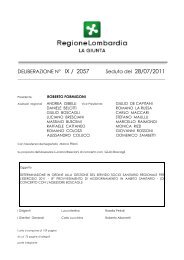La Demenza Vascolare - GrG
La Demenza Vascolare - GrG
La Demenza Vascolare - GrG
You also want an ePaper? Increase the reach of your titles
YUMPU automatically turns print PDFs into web optimized ePapers that Google loves.
<strong>La</strong> <strong>Demenza</strong> <strong>Vascolare</strong><br />
Luca ROZZINI
Dementia is the clinical syndrome<br />
characterised by acquired losses of<br />
cognitive and emotional abilities severe<br />
enough to interfere with daily functioning<br />
and the quality of life.<br />
DS Geldmacher, PJ Whitehouse<br />
N Engl J Med, 335:330-336, 1996
I criteri diagnostici della demenza<br />
(DSM-IV)<br />
• Presenza di deficit cognitivi multipli caratterizzati da:<br />
1) Compromissione mnesica (deficit dell’abilità ad apprendere nuove<br />
informazioni o a richiamare informazioni precedentemente apprese)e<br />
almeno<br />
2) uno o più deficit cognitivi: afasia (disturbo del linguaggio); aprassia<br />
(incapacità ad eseguire attività motorie nonostante l’integrità della<br />
comprensione e della motricità); agnosia (incapacità a riconoscere o<br />
identificare oggetti in assenza di deficit sensoriali); deficit del pensiero<br />
astratto e della capacità critica<br />
• I deficit cognitivi interferiscono significativamente nel lavoro, nelle attività sociali,<br />
nelle relazioni con gli altri, e determinano un peggioramento significativo rispetto<br />
al precedente livello funzionale
The ICD-10 Classification of Mental and Behavioural Disorders<br />
World Health Organization, Geneva, 1992<br />
• Dementia is a syndrome due to disease of the brain, usually of a chronic or progressive nature, in<br />
which there is disturbance of multiple higher cortical functions, including memory, thinking,<br />
orientation, comprehension, calculation, learning capacity, language, and judgment.<br />
Consciousness is not clouded. Impairments of cognitive function are commonly accompanied, and<br />
occasionally preceded, by deterioration in emotional control, social behaviour, or motivation. This<br />
syndrome occurs in Alzheimer's disease, in cerebrovascular disease, and in other conditions primarily<br />
or secondarily affecting the brain.<br />
• Dementia produces an appreciable decline in intellectual functioning, and usually some<br />
interference with personal activities of daily living, such as washing, dressing, eating,<br />
personal hygiene, excretory and toilet activities. How such a decline manifests itself will depend<br />
largely on the social and cultural setting in which the patient lives. Changes in role performance, such<br />
as lowered ability to keep or find a job, should not be used as criteria of dementia because of the<br />
large cross-cultural differences that exist in what is appropriate, and because there may be frequent,<br />
externally imposed changes in the availability of work within
The criteria for MCI are those previously proposed by Petersen et al.<br />
(i) presence of a subjective memory complaint;<br />
(ii) Preserved general intellectual functioning (as estimated in this study by performance on<br />
a vocabulary test);<br />
(iii) demonstration of a memory impairment by cognitive testing;<br />
(iv) intact ability to perform activities of daily living;<br />
(v) absence of dementia.
(i) presence of a cognitive complaint from either the subject and/or a family<br />
member;<br />
(ii) absence of dementia;<br />
(iii) change from normal functioning;<br />
(iv) decline in any area of cognitive functioning;<br />
(v) preserved overall general functioning but possibly with increasing difficulty in<br />
the performance of activities of daily living.
<strong>La</strong> <strong>Demenza</strong> <strong>Vascolare</strong>
…In the Italian study VaD was more prevalent than<br />
AD in subjects 70 years old and older.<br />
Rocca et al.
DSM-III criteria for the diagnosis of multi-infarcts<br />
dementia<br />
A. <strong>Demenza</strong><br />
B. Deteroramento a gradini (cioè non uniformemente<br />
progressivo) con distribuzione dei deficit a scacchiera<br />
(cioè con interessamento di certe funzioni ma non di altre)<br />
all’inizio del decorso<br />
C. Sintomi e segni neurologici focali (per esempio aumento<br />
dei riflessi tendinei profondi, Babinski, paralisi<br />
pseudobulbare, alterazioni della marcia, debolezza di un<br />
arto ecc. )<br />
D. Dimostrazione, fondata sull’anamnesi, sull’esame clinico,<br />
o sugli esami di laboratorio, di una vasculopatia cerebrale<br />
eziologicamente correlata al disturbo.
DSM-IV-R criteria for the diagnosis of vascular<br />
dementia<br />
A. The development of multiple cognitive deficits manifested by<br />
both:<br />
1. Memory impairment (impaired ability to learn new information or to recall<br />
previously learned information)<br />
2. One or more of the following cognitive disturbances:<br />
(a) aphasia (language disturbance)<br />
(b) apraxia (impaired ability to carry out motor activities despite intact<br />
motor function)<br />
(c) agnosia (failure to recognize or identify objects despite intact sensory<br />
function)<br />
(d) disturbance in executive functioning (i.e., planning, organizing,<br />
sequencing, abstracting)
DSM-IV criteria for the diagnosis of vascular<br />
dementia<br />
B. The cognitive deficits in criteria A1 and A2 each cause significant<br />
impairment in social or occupational functioning and represent a<br />
significant decline from a previous level of functioning.<br />
C. Focal neurological signs and symptoms (e.g., exageration of deep<br />
tendon reflexes, extensor plantar response, psuedobulbar palsy, gait<br />
abnormalities, weakness of an extremity) or laboratory evidence<br />
indicative of cerebrovascular disease (e.g., multiple infarctions involving<br />
cortex and underlyig white matter) that are judged to be etiologically<br />
related to the disturbance.<br />
D. The deficits do not ocurr exclusively during the course of a delirium.
Criteri OMS per la diagnosi di demenza vascolare<br />
(Classificazione Internazionale delle Malattie, ICD-10)<br />
• deficit della memoria soprattutto quella a breve termine presente da<br />
almeno sei mesi;<br />
• capacità di giudizio e ideazione relativamente conservate;<br />
• relativa conservazione della personalità e dello stato di coscienza;<br />
• storia di ipertensione arteriosa;<br />
• danno cerebrale focale (in particolare, nelle forme sottocorticali, a livello<br />
della sostanza bianca sottocorticale degli emisferi cerebrali)
Dementia syndrome<br />
It was decided to adopt here the definition of dementia from the 10th revision of<br />
The Neurological Adaptation of the International Classification of Diseases<br />
(ICD-10 NA).<br />
Diagnosis of dementia requires the presence of a decline in memory and<br />
intellectual abilities that causes impaired functioning in daily living.<br />
“Impaired functioning in daily living” was accepted as a criterion for<br />
epidemiologic studies of VaD because it would ensure that the changes are more<br />
than incidental and would increase specificity. Chui et al. also included<br />
“interference with the conduct of the patient’s customary affairs of life” as a<br />
requirement for the diagnosis of ischemic VaD.<br />
The impairment should be due to cognitive deficits and not to physical handicaps<br />
produced by stroke.
Dementia syndrome<br />
For the diagnosis of VaD, cognitive decline should<br />
be demonstrated by loss of memory and deficits<br />
in at least two other domains, including<br />
orientation, attention, language-verbal skills,<br />
visuospatial abilities, calculations, executive<br />
functions, motor control, praxis, abstraction, and<br />
judgment.
The criteria for the clinical diagnosis of<br />
probable vascular dementia include all<br />
of the following:
1. Dementia defined by cognitive decline from a<br />
previously higher level of functioning and manifested by<br />
impairment of memory and of two or more cognitive<br />
domains (orientation, attention, language,visuospatial<br />
functions, executive functions,motor control, and praxis),<br />
preferably established by clinical examination and<br />
documented by neuropsychological testing; deficits should be<br />
severe enough to interfere with activities of daily living not due<br />
to physical effects of stroke alone.
2. Cerebrovascular disease, defined by the presence of focal<br />
signs on neurologic examination, such as hemiparesis, lower<br />
facial weakness, Babinski sign, sensory deficit, hemianopia, and<br />
dysarthria consistent with stroke (with or without history of stroke),<br />
and<br />
evidence of relevant CVD by brain imaging (CT or MRI) including<br />
multiple large-vessel infarcts or a single strategically placed infarct<br />
(angular gyrus, thalamus, basal forebrain, or PCA or ACA<br />
territories), as well as multiple basal ganglia and white matter<br />
lacunes or extensive periventricular white matter lesions, or<br />
combinations thereof.
3. A relationship between the above two disorders,<br />
manifested or inferred by the presence of one or<br />
more of the following:<br />
(a) onset of dementia within 3 months following a<br />
recognized stroke;<br />
(b) abrupt deterioration in cognitive functions; or<br />
fluctuating, stepwise progression of cognitive<br />
deficits.
Clinical features consistent with the diagnosis of probable vascular<br />
dementia include the following:<br />
(a) Early presence of a gait disturbance (small step gait or marche a<br />
petits pas, or magnetic, apraxic-ataxic or parkinsonian gait);<br />
(b) history of unsteadiness and frequent, unprovoked falls;<br />
(c) early urinary frequency, urgency, and other urinary symptoms<br />
not explained by urologic disease;<br />
(d) pseudobulbar palsy; and<br />
(e) personality and mood changes, abulia, depression, emotional<br />
incontinence, or other subcortical deficits including psychomotor<br />
retardation and abnormal executive function.
Clinical diagnosis of possible vascular dementia<br />
may be made in the presence of dementia with<br />
focal neurologic signs in patients in whom brain<br />
imaging studies to confirm definite CVD are<br />
missing; or in the absence of clear temporal<br />
relationship between dementia and stroke; or in<br />
patients with subtle onset and variable course<br />
(plateau or improvement) of cognitive deficits and<br />
evidence of relevant CVD.
Dementia is a deterioration from a known or estimated prior level<br />
of intellectual function sufficient to interfere broadly with the<br />
conduct of the patient’s customary affairs of life, which is not<br />
isolated to a single narrow category of intellectual performance,<br />
and which is independent of level of consciousness.<br />
This deterioration should be supported by historical evidence and<br />
documented by either bedside mental status testing or ideally by<br />
more detailed neuropsychological examination, using tests that<br />
are quantifiable, reproducible, and for which normative data are<br />
available.
Probable IVD<br />
A. The criteria for the clinical diagnosis of PROBABLE IVD include ALL of<br />
the following:<br />
1. Dementia;<br />
2. Evidence of two or more ischemic strokes by history, neurologic signs,<br />
and/or neuroimagingstudies (CT or T,-weighted MRI);<br />
or<br />
Occurrence of a single stroke with a clearly documented temporal<br />
relationship to the onset ofdementia;<br />
3. Evidence of at least one infarct outside the cerebellum by CT or TIweighted<br />
MRI.
Probable IVD<br />
B. The diagnosis of PROBABLE IVD is supported by<br />
1. Evidence of multiple infarcts in brain regions known to<br />
affect cognition;<br />
2. A history of multiple transient ischemic attacks;<br />
3. History of vascular risk factors (eg, hypertension,heart<br />
disease, diabetes mellitus);<br />
4. Elevated Hachinski Ischemia Scale (original or modified<br />
version).
C. Clinical features that are thought to be associated with IVD, but await<br />
further research, include<br />
1. Relatively early appearance of gait disturbance and urinary<br />
incontinence;<br />
2. Periventricular and deep white matter changes on T,-weighted MRI that<br />
are excessive for age;<br />
3. Focal changes in electrophysiologx studies (eg, EEG, evoked<br />
potentials) or physiologic neuroimaging studies (eg, SPECT, PET, NMR<br />
spectroscopy).<br />
D. Other clinical features that do not constitute strong evidence either for<br />
or against a diagnosis of PROBABLE IVD include<br />
1. Periods of slowly progressive symptoms;<br />
2. Illusions, psychosis, hallucinations, delusions;<br />
3. Seizures.
Possible IVD<br />
A clinical diagnosis of POSSIBLE IVD may be made when there is<br />
1. Dementia; and one or more of the following:<br />
2a. A history or evidence of a single stroke (but not multiple strokes) without a<br />
clearly documented temporal relationship to the onset of dementia;<br />
Or<br />
2b. Binswanger’s syndrome (without multiple strokes) that includes all of the<br />
following:<br />
i. Early-onset urinary incontinence not explained by urologic disease, or<br />
gait disturbance (eg, parkinsonian, magnetic, apraxic, or “senile” gait) not<br />
explained by peripheral cause,<br />
ii. Vascular risk factors, and<br />
iii. Extensive white matter changes on neuroimaging.
Conclusions—Current criteria of VaD identify different frequencies and clusters of patients<br />
and are not interchangeable. Optimally, prospective studies with clinicopathological<br />
correlation could identify new criteria. Meanwhile, focus on more homogeneous subtypes<br />
(eg, small-vessel subcortical VaD) and detailed neuroimaging criteria could improve the<br />
diagnostics.
Conclusions: None of the clinical criteria for VaD identified the same group<br />
of subjects. The diagnosis of vascular dementia is difficult in epidemiologic<br />
studies because poststroke dementia can be due to Alzheimer disease (AD)<br />
and evidence of vascular disease can be found in the MRI of dementia cases<br />
without clinical strokes. Whether the clinical progression is related to AD<br />
pathology or vascular disease is difficult to establish.
Clinicopathological Validation Study of Four Sets<br />
of Clinical Criteria for Vascular Dementia<br />
Gold et al.<br />
Am J Psychiatry 2002; 159:82–87<br />
Conclusions: Clinical criteria for vascular dementia are not<br />
interchangeable. The ADDTC criteria for possible vascular dementia<br />
are the most sensitive for the detection of vascular dementia; however,<br />
the DSM-IV criteria for vascular dementia and the NINDS-AIREN<br />
criteria for possible vascular dementia may be more effective in<br />
excluding mixed dementia. Given their inability to detect the vast<br />
majority of cases of vascular dementia, the ICD-10 criteria for vascular<br />
dementia and the ADDTC and NINDS-AIREN criteria for probable<br />
vascular dementia should be revised.
…about a quarter of 3660 participants aged 65 or older had one or more<br />
lacunes on magnetic resonance imaging (MRI)…<br />
…According to several population-based studies, the prevalence of<br />
cerebral white-matter hyperintensities on MRI in elderly people is in the<br />
range of 62–95%...
Subcortical ischaemic vascular dementia<br />
Gustavo C Román, Timo Erkinjuntti, Anders Wallin, Leonardo Pantoni, and Helena C Chui<br />
<strong>La</strong>ncet Neurology 2002;1:426-436
Subcortical ischaemic vascular dementia<br />
Gustavo C Román, Timo Erkinjuntti, Anders Wallin, Leonardo Pantoni, and Helena C Chui<br />
The criteria for the clinical diagnosis include all of the following:<br />
Cognitive syndrome<br />
Dysexecutive syndrome —impairment in goal formulation,<br />
initiation,planning, organising, sequencing, executing, set-shifting<br />
and maintenance, abstracting<br />
Memory deficit —impaired recall, relatively intact recognition,<br />
moderate forgetfulness, and benefit from cues; may be mild<br />
Deterioration from a previous higher level of functioning, interference<br />
with complex (executive) occupational and social activities not<br />
due to physical effects of cerebrovascular disease alone
Subcortical ischaemic vascular dementia<br />
Gustavo C Román, Timo Erkinjuntti, Anders Wallin, Leonardo Pantoni, and Helena C Chui<br />
Cerebrovascular disease<br />
Evidence of relevant cerebrovascular disease by brain imaging<br />
Presence or history of neurological signs consistent with subcortical<br />
cerebrovascular disease (such as hemiparesis, lower facial<br />
weakness, Babinski sign, sensory deficit, dysarthria, gait disorder,<br />
and extrapyramidal signs)
Subcortical ischaemic vascular dementia<br />
Gustavo C Román, Timo Erkinjuntti, Anders Wallin, Leonardo Pantoni, and Helena C Chui<br />
Clinical features supporting the diagnosis of SIVD include the following:<br />
-Episodes of mild upper motor-neuron involvement such as drift, reflex<br />
asymmetry, and incoordination<br />
-Early presence of a gait disturbance (small-step gait or marche à petits pas<br />
magnetic, apraxic-ataxic, or Parkinsonian gait)<br />
-History of unsteadiness and frequent, unprovoked falls<br />
-Early urinary frequency, urgency, and other urinary symptoms not explained<br />
by urological disease<br />
-Dysarthria, dysphagia, extrapyramidal signs (hypokinesia, rigidity)<br />
-Behavioural and psychological symptoms such as depression, personality<br />
change, emotional incontinence, and psychomotor retardation
Subcortical ischaemic vascular dementia<br />
Gustavo C Román, Timo Erkinjuntti, Anders Wallin, Leonardo Pantoni, and Helena C Chui<br />
Features that make the diagnosis of SIVD uncertain or unlikely<br />
include:<br />
Early onset of memory deficit and progressive worsening of memory<br />
and other cognitive cortical functions, such as language<br />
(transcortical sensory aphasia), motor skills (apraxia), and perception<br />
(agnosia), in the absence of corresponding focal lesions on brain<br />
imaging.<br />
Absence of relevant cerebrovascular disease lesions on brain CT<br />
scan or MRI.
Subcortical ischaemic vascular dementia<br />
Gustavo C Román, Timo Erkinjuntti, Anders Wallin, Leonardo Pantoni, and Helena C Chui<br />
CT<br />
Extensive periventricular and deep white-matter lesions: patchy or diffuse symmetrical areas of low<br />
attenuation, of intermediate density between normal white matter and CSF, with ill-defined margins<br />
extending to the centrum semiovale, and at least one lacunar infarct<br />
MRI<br />
Binswanger-type white matter lesions: hyperintensities extending into periventricular and deep white<br />
matter; extending caps (>10 mm as measured parallel to ventricle) or irregular halo (>10 mm with broad,<br />
irregular margins and extending into deep white matter); and diffusely confluent hyperintensities (>25<br />
mm, irregular shape) or extensive white matter change (diffuse hyperintensity without focal lesions); and<br />
lacune(s) in the deep grey matter<br />
OR<br />
<strong>La</strong>cunar cases: multiple lacunes (>5) in the deep grey matter and at least moderate white-matter<br />
lesions; extending caps, irregular halo, diffusely confluent hyperintensities, or extensive white-matter<br />
changes<br />
AND<br />
Absence of haemorrhages, cortical and/or corticosubcortical non-lacunar territorial infarcts and<br />
watershed infarcts; signs of normal pressure hydrocephalus; and specific causes of white-matter lesions<br />
(eg, multiple sclerosis, sarcoidosis, and brain irradiation)
Neuropathology Lessons in Vascular Dementia<br />
Helena Chui, MD<br />
(Alzheimer Dis Assoc Disord 2005;19:45–52)<br />
The hippocampus is the key enabler of episodic memory.<br />
Hippocampal sclerosis (HS) refers to selective neuronal loss in the absence of<br />
cystic cavitation or neurofibrillary degeneration. HS is most prominent in the CA-1<br />
sector of the hippocampus, extending into the subiculum. It has been reported to<br />
be a common neuropathologic finding in persons with dementia who are very old<br />
(80+ yrs),9 among 12% of elderly persons with dementia10 or with cardiac<br />
disease.11 The pathogenesis of HS is still disputed, but systemic hypoxiaischemia<br />
12 and ischemia due to intrinsic cerebrovascular disease are hypothesized, as CA-<br />
1 neurons have a relatively high metabolic rate but relatively poor vascular supply
Conclusions—Our findings suggest that the presence and the<br />
progression of WML are associated with progression of Medial<br />
temporal lobe atrophy in AD. WML may be a predictor of the course<br />
of the disease and a potential treatment target in AD.
Caratteristiche socio demografiche di un campione di 442 pazienti<br />
consecutivamente valutati presso UVA Spedali Civili di Brescia<br />
SIVD<br />
N=71<br />
AD<br />
N=371<br />
Media DS % Media DS<br />
Età 78,6 7,0 74,9 7,2<br />
Sesso 47 71<br />
Scolarità 6,2 3,1 6,4 3,4<br />
CDR 1,1 0,8 1,8 15,9<br />
MMSE 22,0 5,6 21,0 4,4<br />
ADAS 12,1 6,9 17,4 9,2<br />
GDS 5,3 3,7 4,2 3,2<br />
IADL 4,3 2,3 5,1 2,2<br />
BADL 5,0 1,4 5,3 1,1<br />
NPI 16,8 14,9 16,4 12,5<br />
APOE 4 39 53<br />
Ipertensione 75 47<br />
Diabete 17 11<br />
Colesterolo 225,8 41,8 208,7 45,7<br />
Albumina gr 4,2 0,4 4,2 0,4
Although small, the mechanism of action of cholinesterase inhibitors in vascular<br />
dementia is still worth investigating. Vascular lesions, particularly<br />
those that affect subcortical areas, might disrupt the cholinergic pathways to the<br />
cortex, and this might explain why cholinesterase inhibitors are also eff ective in<br />
vascular disease.<br />
Amos D Korczyn<br />
The <strong>La</strong>ncet Neurology 6 September 2007

















